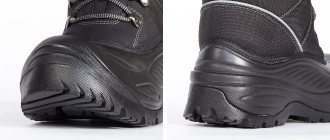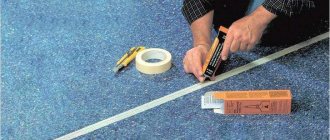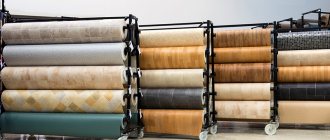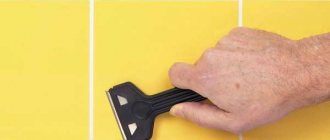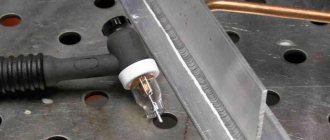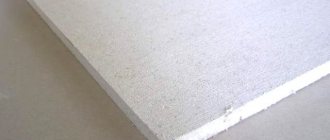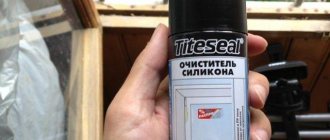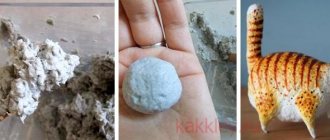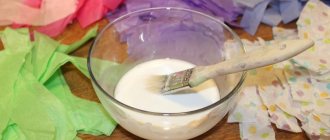Required Tools
The main tool for repairing linoleum is a knife. A dull knife cannot cut even thin material. Construction stores sell special tools for PVC coatings.
- Universal knife. They cut the fabric in a straight line, cut off the frayed edge, and cut out a patch of the desired shape. The blades on the knife are changed. They are made of durable, unbreakable and inflexible material. The blade is held in the handle by a screw. The multi-layer fabric can be easily and evenly cut with a universal tool.
- Retractable reinforced knife. It has a durable anatomical handle and a strong, unbending blade. Easily cuts multilayer linoleum, both straight and at an angle. They cut material in hard-to-reach areas.
- Disc knife. The instrument has a sharp round blade. The canvas is cut straight or along a curved contour, which is convenient for cutting irregularly shaped patches. Using a knife, linoleum is trimmed at thresholds, near niches, ledges, and communication passages.
- Knife in the shape of a month. With a curved blade, it is easy to remove dried glue residues, trim cuts, and remove burrs on the edge of the material. You can make minor repairs to linoleum and smooth out loose seams.
In addition to cutting tools, you need tools for applying markings (ruler with marker) and glue (spatula and roller).
To repair large holes, you need a linoleum patch of the same type as the damaged one. It is difficult to find the same material in the store. When laying a new coating, it is better not to throw away its remains so that you can later use them instead of a patch.
Features of the material
Linoleum is used in different types of premises (private houses, apartments, offices, etc.). Polymer roll coating is also used for laying floors in various workshops and industrial buildings.
Linoleum is very popular today
Tarkett linoleum prices
Linoleum Tarkett
Advantages
The material has many advantages
Polymer flooring has a number of advantages, including:
- ease of installation;
- low cost;
- wide choice of structure;
- variety of colors;
- waterproof;
- high elasticity and density of the material;
- ease of care.
The structure of household linoleum
This is a unique PVC coating that does not require much effort during installation and subsequent maintenance. It is an excellent solution when performing budget renovations in an apartment.
Polyvinyl chloride linoleum
Specifications
Roll production of linoleum provides for the production of products up to 5 meters wide . The length of the material can be from 5 to 40 meters (in some cases, products can have more impressive dimensions). The thickness of linoleum can also be different - from 1.5 mm .
Linoleum is produced in rolls
Note! For laying floors in sports or industrial buildings, a thicker type of linoleum is used (from 5 to 9 mm).
Prices for Juteks linoleum
Linoleum Juteks
Laying features
The base of the material has good sound and heat insulation properties, so linoleum is well suited for laying on concrete without preliminary preparatory work. The concrete screed must be dry and level, otherwise the finished surface will not be of high quality. For installation work, polymer mastic or a special adhesive mixture is used.
Laying linoleum
How can you seal torn linoleum?
Glue or tape will help fix the patch and joints of the separated linoleum. The latter can be either painting or ordinary. The flooring can be glued together using glue or cold welding.
- Bustilate is universal. PVC material is glued to a fabric or felt backing. They are used to glue canvases to wooden or concrete floors, plywood and other porous surfaces.
- PVA for linoleum. Canvases with or without a base are glued to any porous substrate, including chipboard, fiberboard, screed or plank flooring.
- Homakoll. Product for coverings with fabric, fluff or foam backing. Linoleum is laid on a concrete screed, wooden boards, plywood and fiberboard.
- AdesilexG. Reactive adhesive based on polyurethane. Can be glued to absorbent and non-absorbent materials. Can be used in damp areas.
- Homakoll S. Seams seams (joints), repairs minor damage such as punctures, small cuts with a smooth edge.
Scratches, burns and small punctures are repaired with mastic or polymer putty. To ensure that the adhesive seams match the color of the linoleum, fine crumbs scraped off from its remains are added to the glue.
There are repair kits that include mastic, solvent, and dye. With them, any minor defect will become almost invisible.
Types of damage
There are several types of damage that owners of PVC-coated floors have to deal with. Below are the most common ones.
Types of linoleum
Table. Typical damage to linoleum.
| Damage, photo | Description |
| Attrition | Appears against the background of long-term use of the floor covering. The abrasion often appears locally, for example, under chairs. |
| A cut | Cuts may be the result of careless manipulation of sharp objects. Cuts occur relatively rarely. |
| Breakdown | When using furniture with sharp legs, pinpoint damage to the linoleum is possible. To avoid breakdowns, special gaskets are used. |
| Through gap | Dragging heavy objects across linoleum with a drag can cause through tears in the flooring material. |
| Spot | Occurs when the surface comes into contact with chemicals or fats. As a rule, such stains appear in the kitchen. |
Despite the variety of damages and ways of their occurrence, it is possible to restore the original appearance of linoleum without the help of specialists. To do this, you need to choose one of the effective methods and follow the instructions.
How to eliminate bubbles on linoleum
Correction of minor defects
A small cut or crack must be repaired immediately after detection, otherwise dirt and dust will become clogged with it, which will lead to protruding edges and an enlargement of the hole.
Subtle defects on linoleum can be repaired using the following means.
- Mastic. It comes in paste or pencil form and in different colors.
- Cold welding. Any defects of any complexity are quickly eliminated. Dissolves the top layer of linoleum, after drying the damaged area will be invisible.
- Sealant. Wood sealant is used for PVC sheets.
Scuffs on linoleum can be easily corrected with special wax. Wax is rubbed into a small defect using the edge of any coin, and then the area is rubbed with a soft cloth until it has a glossy shine. Mastic or polish is suitable for covering up abrasions. Before repair work, the coating is cleared of debris and dirt, dried, and the desired area is degreased.
Cold welding is used to repair small through holes. It reliably seals holes with a diameter of no more than 0.3-0.4 cm. Masking tape is applied around the damage so that welding does not damage the rest of the coating. The glue is applied with a thin spout to the hole. Its edges melt, and the hole itself closes, becoming invisible. After the welding has dried, the tape is peeled off, and its excess is removed with a knife. Due to high toxicity, they work in a respirator and gloves, in a room with good ventilation.
Minor damage can be repaired with a homemade composition:
- 0.5 kg of powdered colophon resin is melted in a water bath;
- the mass is cooled to 50 °C;
- the composition contains 0.15 liters of alcohol, 0.1 kg of castor oil;
- the mixture is tinted with dye;
- the resulting glue is injected into the hole with a syringe without a needle;
- The area can only be loaded after the glue has hardened.
How to clean brilliant green from linoleum spilled due to carelessness
It is known that brilliant green is very quickly absorbed into various surfaces, especially porous ones, and is not so easy to wash off later.
If you do spill brilliant green on the linoleum, you need to immediately blot it up with a napkin. But under no circumstances should you smear it on the surface.
If you spill a lot of liquid, you need to sprinkle the puddle with an absorbent that will absorb most of the green liquid. Table salt can be used as an absorbent.
After the brilliant green is absorbed, the absorbent should be carefully removed.
Now let’s try to wash off the brilliant green stain from the surface of the linoleum.
It must be said that there are recommendations for removing brilliant green stains using various means, but in fact, not all of them are effective. Some of them don't help solve the problem at all. Therefore, I will briefly talk about each of them so that you do not waste your time and nerves.
Baking soda and vinegar are not at all capable of removing stains, so they are not suitable for this purpose.
A stationery eraser does not help much in removing stains.
Kerosene is not capable of removing stains at all.
Ammonia – removes the stain, but not completely.
Acetone removes stains well, but a little worse than solvent.
Solvent 646 - quickly removes stains, but do not be too zealous so as not to damage the decorative layer of linoleum.
Nail polish remover - quickly and easily removes paint stains from the surface of linoleum.
As you can see, it is preferable to use nail polish remover or solvent 646 for this purpose.
By the way, if you have a need to remove not brilliant green from linoleum, but the smell of cat urine, which also happens quite often, then we can recommend several proven options.
You can use special chemicals such as zoovillus, Bio-G, Complete Pet.
You can also use improvised means, which are also quite effective.
Food grade 70% vinegar, diluted half with water, not only quickly removes the unpleasant odor, but also subsequently weans the animal from relieving itself in this place.
Potassium permanganate, diluted to a bright pink color, also works well to remove the persistent smell of cat urine.
Repair of large ruptures
The only way to close a large hole in linoleum is to patch it.
- A piece of fabric for the patch is selected, which should be the same color and with the same pattern. It is laid over the hole and aligned with the pattern lines along the edges of the hole.
- The patch is fixed to the canvas with masking tape. A small section can only be secured in the corners.
- Using a knife, carefully cut both layers of material along the lines of the pattern. It is better that the patch has a square or rectangular shape for easy fastening and unnoticeable joints.
- The tape is removed, the linoleum trimmings are removed, and the patch is put aside. The damaged area is pryed with a knife and torn off from the base. The remains of old mastic are cleaned from the floor to improve the adhesion of the patch to it.
- The glue is carefully applied to a clean base with a spatula. If the edge around the cut protrudes, it is also glued - the edges of the linoleum are bent outward, coated with glue and pressed to the floor.
- After a few minutes of waiting, a patch is placed on the glue and carefully smoothed over the entire surface to remove air bubbles. The patch is placed evenly and must match the drawing.
- A roller is rolled over the patch, and excess mixture is removed with a clean, damp cloth.
- The seams on all sides of the patch are treated with joint glue, and the excess is removed. When the glue sets, wipe the joints with a washcloth or thick cloth.
Complete drying will occur within a day. Do not load the sealed area at this time.
Bonding with mastic
Mastic is one of the most popular adhesives. It makes it easy to glue linoleum at home. The method is reliable, it connects “tightly”, but if you need to remove the coating for a while, then the linoleum will tear in the place where the mastic was used. It is also easy to attach the raised piece this way.
Work order:
- Before gluing the joints, prime the base.
- The edges of the coating are degreased with any alcohol-containing product. Acetone or solvents cannot be used, as they can corrode the linoleum.
- As soon as the base has dried, you need to apply a small amount of mastic to it with a spatula.
- Then the edges of the linoleum are applied to the surface and pressed tightly. The joint must be carefully rolled with a hard roller.
The mastic dries for about a day, so during this time the area where the coating has been treated needs to be pressed firmly with something heavy. A board is placed on the joined edges, and a load is placed on it.
Repair of the burnt area
- Burnt through the top protective layer. The stain is cleaned of dirt and burnt particles. Using the side surface of the coin, mastic is applied to the defect and gently smoothed.
- The pattern and the PVC layer have burned through. Spots with darkened edges and a white or yellow center are repaired by cold welding. For new linoleum, type A glue is used, the old coating is repaired with type C. It is enough to lubricate the burn and wait for it to melt.
- Through hole. It can be fixed with a patch or a special sticker. Attached to the hole by cold welding.
Restoration of joints
A poorly taped seam between the canvases may come apart. If there is a discrepancy near doors, under furniture or along a wall, the defect is easily covered with a decorative threshold. In the center of the room it is better to use cold or hot welding.
Hot is done only by professionals (you need skills and a hot air gun). The technician heats up the PVC cord and places it in the joint.
Cold welding is relevant in everyday life:
- one strip is pulled over the second with maximum overlap (optimally when its width is at least 2 mm);
- A metal ruler or strip is placed in the center of the overlap and markings are made with a pencil;
- a cut is made along the drawn strip, excess strips of linoleum are removed;
- glue is poured into the resulting cut using a thin tip;
- After the weld has hardened, excess glue is removed.
How to apply a patch
If the damaged area is large enough, it will have to be replaced. You just need to choose a piece of the same color so that you can match the pattern as much as possible.
On a note
It is advisable to save the remaining material after installing the floor; it may be useful in the future for repair work. The waste patch will be almost invisible.
Sequence of repair work:
- approximately determine the size of the patch;
- a new piece of canvas is placed on the repaired area and the pattern is adjusted;
- then use a sharp knife to cut through both sheets around the perimeter. It is better to do this by laying a metal ruler along it;
- the damaged material is removed and the exposed area of the base is cleaned with emery cloth;
- the patch around the perimeter is trimmed a few millimeters. This is necessary so that she can freely enter the area being repaired;
- if the floor was laid with glue, a patch is also glued, but if it is a floating floor, it is welded along the edges.
Removing waves and bulges
- The easiest way to remove waves is at the edge of the canvas. The baseboard is removed, the linoleum is moved, reducing the distance between its edge and the wall. The excess part on the other side can simply be cut to the desired size. You can fasten the canvases with plinths only two days after leveling, when they are completely straightened.
- When a bulge appears in the center of the canvas, the bubble must be pierced with a needle, the accumulated air must be released, and the surface should be straightened with your hands. Glue is released through the puncture with a syringe, and the area is pressed with a weight. Large bubbles are cut with a blade, and after removing the air, the cut is sealed with cold welding.
How to remove waves on linoleum after installation in an accessible way
And so, you laid new linoleum and discovered that your joy was darkened by the fact that waves appeared on it.
Why do waves appear on linoleum?
There may be several reasons.
The first common reason for the appearance of waves is that you purchased linoleum in advance, and it lay with you for quite a long time. In this case, the roll changes shape from cylindrical to elliptical.
Or perhaps you did not roll it tightly with a large roll diameter. Then the roll will sag and take the shape of an ellipse immediately or in a couple of days.
In this case, after laying linoleum, even glued to the floor, transverse waves will appear on the canvas.
It is possible to fight this phenomenon.
They usually do it in one of two ways.
The first method is to take a hair dryer and begin to gradually heat each wave from start to finish, while smoothing it out with a hard roller or spatula.
If you do not have your own hair dryer, then it is hardly worth purchasing one for one-time use. In this case, you need to either borrow a hairdryer from someone, or use a regular iron to repair linoleum.
To do this, you need to take a towel or rag made of natural, not synthetic, fabric, place it at the beginning of the wave and smooth the wave on the linoleum with smooth movements of the iron. In this case, the linoleum should warm up sufficiently, but not “float”.
As a result, you will get approximately the same result as in the photo.
If barely noticeable waves still remain, then don’t be upset. The linoleum will sit for some time and the waves will disappear completely.
In another case, waves on the linoleum may appear along the walls. This is possible for two reasons.
The first is when linoleum is laid without a gap near the walls. As a result of heating and expansion, linoleum begins to rest against the wall and form a wave.
In this case, you need to remove the plinth, trim the linoleum correctly so that there is a gap of 5-10 mm from the wall, straighten the linoleum and install the plinth back. In this case, the wave on the linoleum will disappear.
The second reason for the appearance of waves on linoleum along the walls is the installation of the baseboard too tightly. If you pressed the plinth too hard against the linoleum, then when you fasten it, the plinth will turn inside the room and move the linoleum. As a result, a wave will be formed.
The method for removing the defect is obvious. It is necessary to reinstall the baseboards without pressing them too much to the floor.
And the last reason for the appearance of waves may be that you purchased cheap and not very high-quality linoleum that does not have a good backing. In this case, the structure of such linoleum is not stable enough and, as a result, waves appear in different directions of the canvas.
This case is the most difficult and it is not possible to guarantee a good result after repair. Especially if you laid linoleum without sizing. Such linoleum must be glued to the floor. This operation is not very complicated and you should not save on it. You can read in detail about laying linoleum in my article “Do I need to glue linoleum to the floor?”
In this case, you need to remove the baseboards, smooth out the linoleum, let it rest for at least a day, trim it at the walls as required and then glue it to the floor.
Removing dents and holes
- Iron. Place a cloth moistened with water on the dent. You need to run a heated iron over the rag (must work in steamer mode). One large dent will need to be ironed for at least half an hour.
- Hair dryer. The dent is heated with a hairdryer until it disappears. On average it takes at least an hour.
- With a needle. The dent is made exactly in the middle. Air will enter through the hole and the canvas will level itself. Additionally, you can place a weight on the floor at the puncture site.
On top of the dent, you can apply leveling mixtures consisting of alcohol, rosin and castor oil, combined in a ratio of 5:25:4. The composition fills the dent, levels out and dries. After drying, it is rubbed with sandpaper.
How to remove a dent on linoleum from heavy or sharp objects
One of the most common defects of linoleum during operation are dents caused by heavy or sharp objects. If the structure of the linoleum is not destroyed, then such a dent can be removed.
To remove dents on linoleum, you will need a regular household hair dryer and a hard, lint-free roller.
Use a hairdryer to heat the dent and roll it out with a roller several times. The first time, of course, it will not disappear, but it will begin to decrease. If you repeat this simple operation 5-6 times, you can completely get rid of the dent if it is not too deep.
As you can see, the result was quite acceptable, and without much effort.
Now you know how to repair linoleum on the floor without spending a lot of time on it.
It must be admitted that high-quality linoleum is less susceptible to various defects and damage. You can read about how to choose high-quality and not too expensive linoleum in the article “How to choose linoleum for your home based on quality - advice from an expert.”
